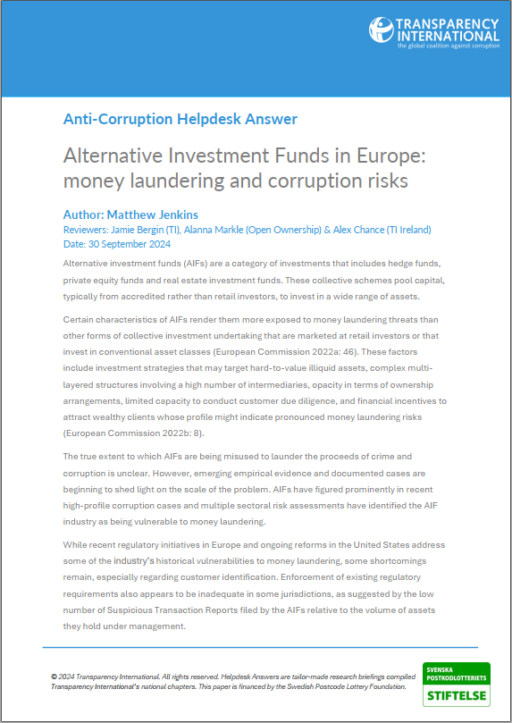- Home
- Anti-Corruption Helpdesk
- Alternative Investment Funds in Europe: money laundering and corruption risks
Alternative Investment Funds in Europe: money laundering and corruption risks

This Anti-Corruption Helpdesk brief was produced in response to a query from a Transparency International chapter. The Anti-Corruption Helpdesk is operated by Transparency International. The project is supported by The Swedish Postcode Lottery Foundation.
Query
Please provide a summary of the money laundering and corruption risks associated with alternative investment funds.
Summary
Alternative investment funds (AIFs) are a category of investments that includes hedge funds, private equity funds and real estate investment funds. These collective schemes pool capital, typically from accredited rather than retail investors, to invest in a wide range of assets.
Certain characteristics of AIFs render them more exposed to money laundering threats than other forms of collective investment undertaking that are marketed at retail investors or that invest in conventional asset classes (European Commission 2022a: 46). These factors include investment strategies that may target hard-to-value illiquid assets, complex multi-layered structures involving a high number of intermediaries, opacity in terms of ownership arrangements, limited capacity to conduct customer due diligence, and financial incentives to attract wealthy clients whose profile might indicate pronounced money laundering risks (European Commission 2022b: 8).
The true extent to which AIFs are being misused to launder the proceeds of crime and corruption is unclear. However, emerging empirical evidence and documented cases are beginning to shed light on the scale of the problem. AIFs have figured prominently in recent high-profile corruption cases and multiple sectoral risk assessments have identified the AIF industry as being vulnerable to money laundering.
While recent regulatory initiatives in Europe and ongoing reforms in the United States address some of the industry’s historical vulnerabilities to money laundering, some shortcomings remain, especially regarding customer identification. Enforcement of existing regulatory requirements also appears to be inadequate in some jurisdictions, as suggested by the low number of Suspicious Transaction Reports filed by the AIFs relative to the volume of assets they hold under management.
Main points
- Alternative Investment Funds (AIFs) represent a significant portion of assets under management globally. In 2023, the industry amounted to approximately US$ 22 trillion globally.
- Certain characteristics of AIFs may make them attractive to criminals seeking to launder illicit proceeds and generate profits from these investments, and there is emerging evidence that these types of investment structures are being misused in this way.
- There are four main ways in which corruption can affect AIFs (Luxembourg CSSF 2020: 29). First, inbound capital from investors to AIFs might originate from politically exposed persons (PEPs) who have embezzled the funds or received a bribe. Second, AIFs may invest in entities and projects linked to corrupt government officials. Third, intermediaries such as investment managers or advisors may seek to unduly influence investment decisions due to a conflict of interests. Fourth, AIFs such as private equity funds may (inadvertently or otherwise) invest in portfolio companies that engage in corrupt practices.
- Hedge funds, private equity funds and real estate funds targeted at accredited investors appear to pose greater risks than investment vehicles marketed towards retail investors. This is due to the nature of alternative asset classes, fund managers’ incentive structures and close relationships with wealthy (and potentially politically exposed) clients desirous of secrecy, and the opacity and complexity of legal structures investing in AIFs.
- Some of the assumptions that AIFs face only limited exposure to ML threats as a result of factors like long lock-up periods appear to be misplaced, especially with regard to corrupt actors from states characterised by authoritarian rule who may have longer investment horizons.
- Outsourcing AML obligations is a common practice in the AIF industry, yet the standard of AML controls conducted by these third parties is difficult to ascertain and may be highly variable.
- FATF Mutual Evaluation Reports of several countries have commented on the low number of Suspicious Transaction Reports (STR) filed by the AIF industry in relation to its size. This may contribute to fewer investigative leads for law enforcement agencies and a lack of understanding of the industry’s risk profile on the part of governments.
- Enforcement efforts by AML supervisory bodies in some European jurisdictions with large AIF industries appear to be currently insufficient relative to the scale of the challenge.
- A 2024 survey found that 73% of industry insiders stated that ML risks have increased in the past two years (OCORIAN 2024). The rapid growth in the magnitude of the industry (Filbeck 2024) likewise suggests that the misuse of AIFs will remain a concern with potentially sizeable impacts on wider society.
Contents
- Introduction
- Corruption and ML risks in undertakings for collective investments
- Corruption risk factors and cases across different AIF categories
- Hedge funds
- Private equity and venture capital
- Real estate
- Funds of funds
- Other types of AIF
- Regulatory framework in Europe
- References
Caveat
While much has been made of recent regulatory initiatives by US authorities to close loopholes that heighten money laundering risks in the investment industry (FINCen 2024a; 2024b), this Helpdesk Answer focuses primarily on the situation in the European Union. It nonetheless occasionally draws on examples from other jurisdictions where these are especially illustrative of the underlying challenges.
There is growing concern about the role family offices can play in facilitating the laundering of the proceeds of crime and corruption (Hanley-Glersch 2024; Kumar 2022). Nonetheless, this Helpdesk Answer does not include family offices as they have not traditionally been considered to be AIFs under EU Directives (European Union 2011) or Guidelines issued by the European Securities and Markets Authority (2015: 4). This is because they do not raise capital from external investors but rather members of a pre-existing group, in other words, the family (UK FCA 2022).
Finally, there are ample cases of fraud in the investment funds industry, such as insider trading, price manipulation, financial reporting fraud and Ponzi schemes (see Alexander and Cumming 2020; Bosua 2020). This Helpdesk Answer consciously limits itself to consideration of risks relating to these vehicles being used to launder the proceeds of crime and corruption.
Authors
Matthew Jenkins
Reviewers
Jamie Bergin (TI), Alanna Markle (Open Ownership) & Alex Chance (TI Ireland)
Date
10/10/2024
Tags
 Download PDF
Download PDF
